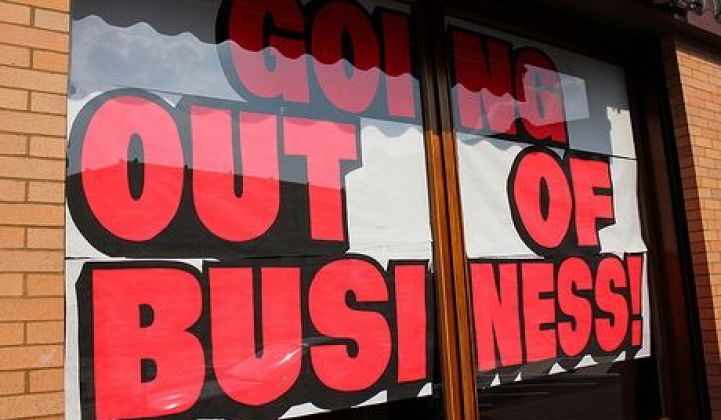Silent Power, a startup piloting combined solar PV-battery storage projects in California and its home state of Minnesota, has gone out of business, according to a news report. It’s not the first energy storage startup to fail -- and with the market for grid-scale storage still in its infancy and profitable models to commercial-scale deployment still unclear, it may not be the last.
Silent Power closed its doors in the last week of January, according to the Brainerd Dispatch newspaper. The reason, according to CEO John Frederick, was the failure of investor and strategic partner Hanwha Group to provide an additional round of funding to keep the business afloat.
The South Korean industrial conglomerate invested $8 million in Silent Power in mid-2012, with plans to bring a combined solar-battery-inverter commercial offering to market via its solar business unit, Hanwha SolarOne. Frederick told the Brainerd Dispatch that Hanwha’s decision not to provide additional funding forced the startup to wind down operations, with plans for its secured lender, the Initiative Foundation, to sell the company’s assets and intellectual property, including software and hardware designs.
Greentech Media’s calls to the Baxter, Minn.-based startup’s headquarters were met with a busy signal. The company’s website had no information related to its closure as of Monday.
UPDATE: Hanwha Group provided this statement regarding its relationship with Silent Power: “The Hanwha Group made an investment in Silent Power as part of an exploration of energy storage technology for use by its solar business units. Initially, Hanwha SolarOne tested applications of Silent Power’s technology, but that ended in late 2012. The Hanwha Group continued evaluating the Silent Power technology until early this year when the Group decided to discontinue that effort. The Hanwha Group makes investments in many early stage companies and not all of them make it to market.”
In a 2009 interview with Greentech Media, Silent Power’s former CEO, Todd Headlee, laid out the company’s plans to provide battery storage for solar-PV-equipped homes, both to provide emergency power backup for homeowners and grid management capabilities for utilities. He noted that the company had raised about $4 million in angel financing, had sought to partner with General Electric on some unspecified solar-storage proposals, and was working with California utilities including Sacramento Municipal Utility District (SMUD).
SMUD did deploy some Silent Power systems in 2010, in partnership with French lithium-ion battery supplier Saft under a Department of Energy grant-funded project. But according to Patrick McCoy, SMUD’s solar program planner, that project ran into a number of problems, and the municipal utility has since moved on to other partners for its ongoing solar-energy storage projects.
Silent Power also launched a project with three Minnesota electric cooperatives in 2012, again funded by a DOE grant, to install solar backup battery systems in about 130 homes. As of October 2013, two of the co-ops had installed a total of five of Silent Power’s 10-kilowatt storage appliances in utility and public buildings.
While details on other deployments aren’t available, it would appear that Silent Power and Hanwha were unable to find larger customers for their solar-storage offering. That stands in contrast to a number of other battery-based energy storage startups, such as Stem in California and Green Charge Networks in New York, which have been able to deploy a significant number of systems and line up financing for megawatts more.
One key difference is that Stem and Green Charge Networks are targeting commercial buildings, which have a stronger economic incentive to use energy storage to reduce their demand charges. Those are costs accrued for exceeding certain thresholds of energy usage in any given period of time, and they can add up to significant parts of overall utility bills in several key markets.
Meanwhile, commercial customers are also looking for ways to use batteries to better integrate on-site solar PV into their broader energy cost management needs. GTM Research’s recent report, Distributed Energy Storage 2014: Applications and Opportunities for Commercial Energy, forecasts that the U.S. commercial energy storage market will expand at a cumulative annual growth rate of 34 percent to reach 720 megawatts by 2020, with demand charge reduction and solar PV integration driving that growth.
But as GTM Research’s report makes clear, the business case for residential energy storage is nowhere near as strong as it is for commercial demand charge reduction. While emergency backup power may be attractive to well-heeled homeowners, it doesn’t really pencil out on an economic basis. Future applications, like shifting consumption to avoid peak electricity prices, aren’t yet lucrative enough to make sense in U.S. markets -- and are often barred by regulations or utility roadblocks to allowing them low-cost interconnection with the grid, as is happening in California.
That hasn’t stopped some intrepid companies from deploying residential solar-battery systems, of course, but it has severely limited the economic case for such deployments. U.S. third-party solar installer SolarCity is installing batteries in California homes, for example, but largely as a statewide pilot project. Meanwhile, SolarCity has recently launched commercial-scale solar-battery projects with demand charge reduction as the primary economic driver.
Energy storage startups have landed quite a bit of venture capital investment in the past few years, but it’s likely that not all will make it through the coming years. Grid-scale battery startup Xtreme Power filed for bankruptcy protection last month, despite having more than 66 megawatts of systems installed around the country. With Silent Power joining the ranks of deceased energy storage startups, it’s worth considering whether this is the start of a trend.



